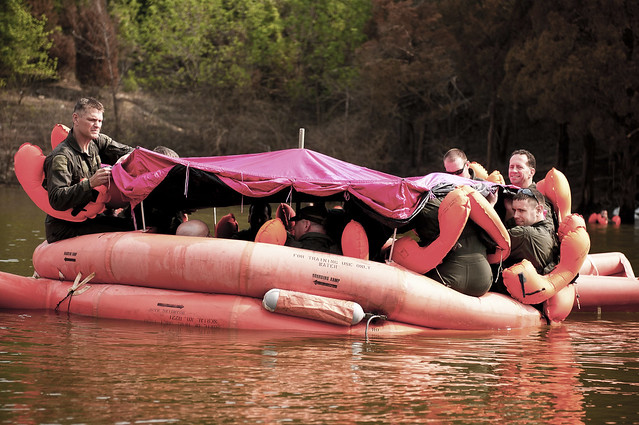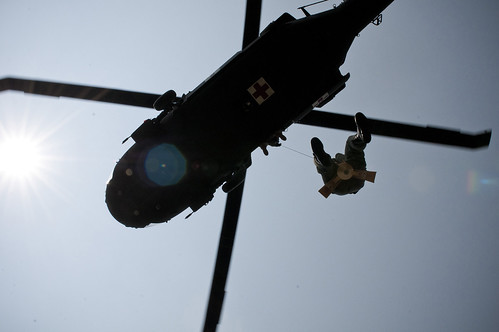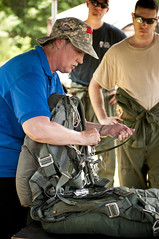mjo
Story by Master Sgt. Philip Speck, 123rd Airlift Wing Public Affairs
[caption id="" align="aligncenter" width="576" caption="Col. Barry Gorter (far left), commander of the 123rd Operations Group, sets up a life raft with other Airmen from the Kentucky Air National Guard during survival training at Taylorsville Lake in Taylorsville, Ky., on June 9, 2011. The training is required of aircrew members every three years. (U.S. Air Force photo by Senior Airman Maxwell Rechel)"]

Click here for more photos on this story.
TAYLORSVILLE, Ky. — More than 120 aircrew members and intelligence specialists from the Kentucky Air National Guard conducted life-saving land- and water-survival training at Taylorsville Lake here June 9 and 10.
[caption id="" align="alignleft" width="360" caption="Medical evacuation troops from the Kentucky Army National Guard hoist Capt. Jennifer Nash, a Kentucky Air Guard C-130 pilot, into a UH-60 Blackhawk during land-survival training held June 9, 2011, in Taylorsville, Ky. Nash was participating in a two-day course designed to augment her survival skills. (U.S. Air Force photo by Senior Airman Maxwell Rechel)"]

The training, which covered topics like land navigation and emergency egress from a downed aircraft, is required for aircrew members every three years, said Lt. Col. Ronald Whelan, commander of the 123rd Operations Support Flight. It builds on an extensive three-week combat-survival course that all aircrew members must complete in Spokane, Wash., as part of their initial training.
“The scenarios we’re training for here are certainly the kinds of things we hope will never happen in real life, but we need to be prepared for them,” Whelan said. “The idea is that our reactions will become second-nature in the event of a real emergency.”
Chief Master Sergeant Joan Hazel, who helped organize the training, said repetition is key.
[caption id="" align="alignright" width="159" caption="Chief Master Sgt. Joan Hazel, superintendent of the Kentucky Air National Guard’s Aircrew Flight Equipment Section, demonstrates during survival training June 9, 2011, how Airmen can disentangle themselves from parachutes if they become lodged in trees after jumping from disabled aircraft. The training was part of a two-day course held in Taylorsville, Ky. (U.S. Air Force photo by Senior Airman Maxwell Rechel)"]

“We hear stories, over and over again, about how this information comes back to the forefront of crewmembers’ brains during real-world emergencies and they’re able to use their knowledge,” said Hazel, superintendent of the Kentucky Air Guard’s Aircrew Flight Equipment Section, which conducted the course. “It’s really good stuff.”
The land portion of the training covered radio usage, compass-reading, land navigation, concealment techniques and firecraft — the use of flares and other incendiary devices. Instructors also provided a “hanging-harness” course, which teaches aircrew members how to extract themselves from trees if their parachutes get snagged after jumping out of a plane, Hazel said.
Water-survival training gave aircrew members the opportunity to deploy and use rubber survival craft such as a 20-person boat or a one-person raft. Students were then pulled across the lake by a motorboat to simulate what it would be like if they had landed in the ocean by parachute, and the tides had begun to drag them across the surface of the water by pulling on the parachute canopy. Students were required to release their canopies to stop the dragging action.
“Training like this gives us the opportunity to get out here and work with equipment that we don’t get to work with that much,” said Capt. Casey Clark, a C-130 pilot with Kentucky’s 165th Airlift Squadron. “I’ve really appreciated the enthusiasm of the flight-equipment folks we come out here to work with,” he added “They genuinely have a passion for what they do, and they really impress upon us the importance of knowing the equipment and helping us learn how to use it accurately so that we can help ourselves in situations we hope we never get into.”